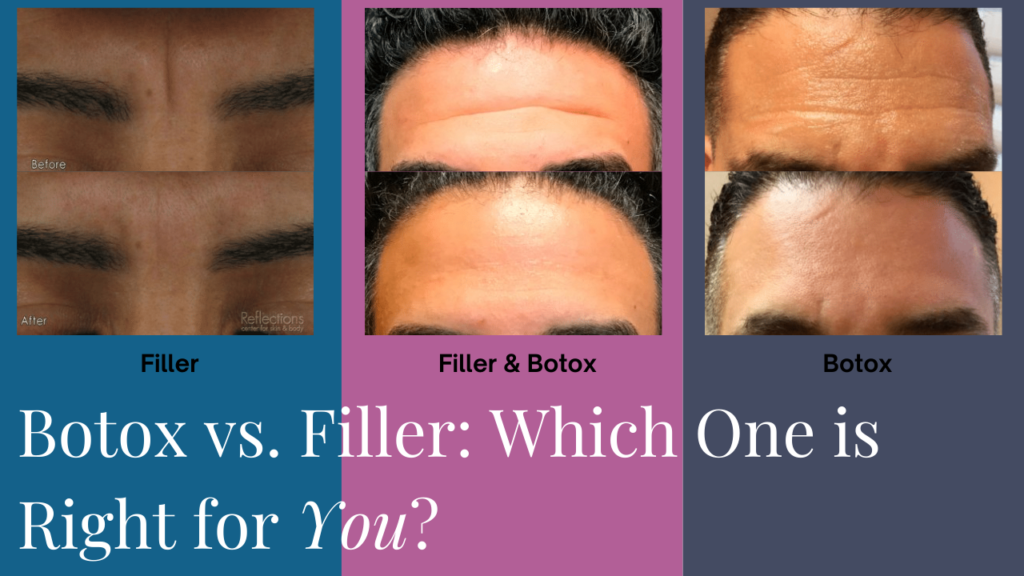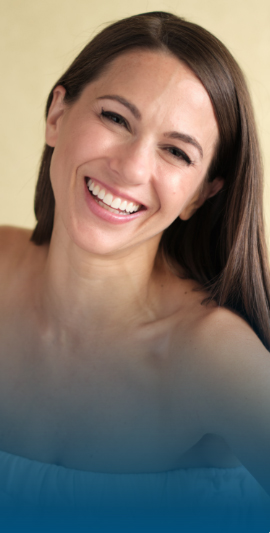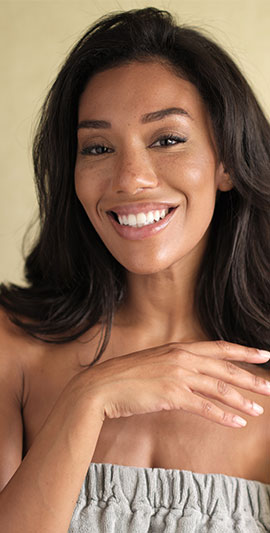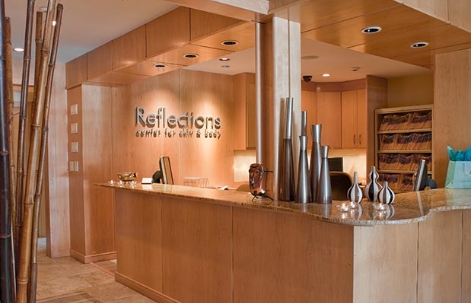Botox vs. Filler for Wrinkles
If you’re interested in treating wrinkles with injectable products, it can be difficult to know which product might be right for you. There are so many types and brands of injectable products available, and Allergan makes both Botox and fillers, so if you’re just getting started with your treatment, it can be confusing. Here are some of the basic differences between Botox and fillers and their uses.
Botox vs. Filler – How Do They Work?
Botox and dermal fillers can each be used to reduce wrinkles, but they work in different ways.

Botox
Botox is a neuromodulator, meaning that it slows communication between nerves and muscles. This causes the skin to bend less, which will smooth wrinkles caused by repetitive movement, including repeated facial expressions. These types of wrinkles are found all around the forehead and eyes including crow’s feet on the corners of the eyes, frown lines (glabellar lines) between the brows, and horizontal forehead lines. Botox can also be used to treat a gummy smile (lip flip procedure) and improve dimpling of the chin and downturned corners of the mouth. It’s even injected into the masseter muscle (jaw muscle) to treat TMJ and/or slim the jawline. Platysmal bands on the neck (vertical neck bands) can also be smoothed with Botox.
Fillers
Fillers are often used in combination with Botox to simultaneously add volume to various areas of the face. There are many different types of fillers so it’s important to use the right one for specific areas. For example, some fillers have a stiff consistency that builds structure in the cheeks or jawline. A more flexible, elastic filler will be used around the mouth, including nasolabial folds or laugh lines, and in the lips so that it moves naturally with facial movements.
Different types of fillers work in different ways, but there are a few basic categories that they may fall into.
Hyaluronic Acid Fillers
Hyaluronic acid fillers are the most commonly used in the US, because of their natural texture and ability to be reversed. Hyaluronic acid (HA) is a naturally-occurring molecule within our skin that bonds to water. The amount of HA in your skin naturally decreases with age, so replacing it with injections can create a very natural result. Various hyaluronic acid fillers have different consistencies, so your injector may recommend a specific product depending on the area you are treating. You could place hyaluronic acid fillers in the following categories:
- Voluma and Lyft: Very firm and bouncy texture, good for deep lifting
- Silk, Belotero, and Volbella: Very thin and flowing texture, good for very fine or superficial lines
- Refyne, Defyne, and Vollure: Gel-like consistency, best for high-movement areas
- Restylane and Juvederm: Medium firmness, useful for the soft, squishy parts of your face – considered the workhorses – these 2 are the oldest technologies and the most widely used. Want to better understand their differences? Check out this blog on Juvederm vs. Restylane.
- Kysse – medium firmness filler specifically designed to hold up to high movement in the lips
Non-Hyaluronic Acid Fillers
Non-hyaluronic acid fillers include the products Bellafill, Radiesse, and Sculptra. Bellafill is a long-lasting filler with immediate results that uses small spheres of collagen instead of hyaluronic acid to create an instant result, but also contains a substance that triggers the growth of new collagen. Meanwhile, Sculptra and Radiesse make use of 2 different types of injectable material that both work by stimulating your natural collagen production. This leads to long-lasting effects, and the products are useful for increasing your skin’s overall firmness and resolving fine lines.
Wrinkles, Fine Lines, and Deep Folds: Does Botox or Filler Work Best?
Deciding which injectable product is best often depends on the cause of your lines and whether they are considered wrinkles, fine lines, or deep folds.
Deep folds in the skin are generally caused by volume loss, which naturally occurs as we age. The most common example are nasolabial folds (or smile lines around the mouth), which are deep lines that form between the nostrils and lips. Volume loss is always best-treated by restoring volume with a filler, as opposed to Botox, or even a skin tightening procedure, like Sofwave or Ulthera.
Wrinkles are usually caused by repetitive motion, skin weakness or damage, or environmental factors like sun damage.
Wrinkles caused by repetitive motion can be well-treated with Botox, while other wrinkles may be best suited to a filler. In some instances, such as perioral lines or “smoker’s lines,” you may be best treated with a combination, so that you fill in the existing wrinkles with filler to lift the skin up to match the surrounding surface height, and then use Botox to reduce the intensity of those facial expressions, so that you’re
Fine lines, especially those that appear in multiples or in areas with crepey skin point to a lack of collagen support in the skin, which can be improved with non-hyaluronic-acid fillers, and sometimes that result can be supported by reducing the damage of frequent motion with some light Botox injections.
Who Should I Receive Injectables from?
Choosing the correct product for a patient is dependent on many factors, and requires extensive training, experience, and understanding of Botox and fillers. Injectables are offered by a wide variety of practitioners as they become more common, but it’s best to invest in high-quality treatment from a qualified provider. At Reflections Center, our injectable treatments are performed by cosmetic physicians who have a deep understanding of the products and effective, safe treatment of lines and wrinkles.
Schedule an Appointment
To learn more about which injectable product is right for you, schedule a free consultation appointment with one of our physician injectors. These are currently available both in-person and virtually. Our expert staff will work to understand the cause of your wrinkles, folds, or fine lines and develop the best treatment plan for you.







